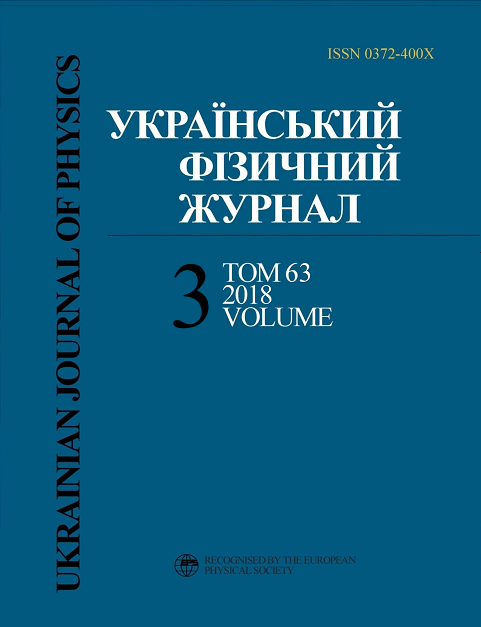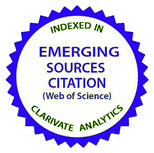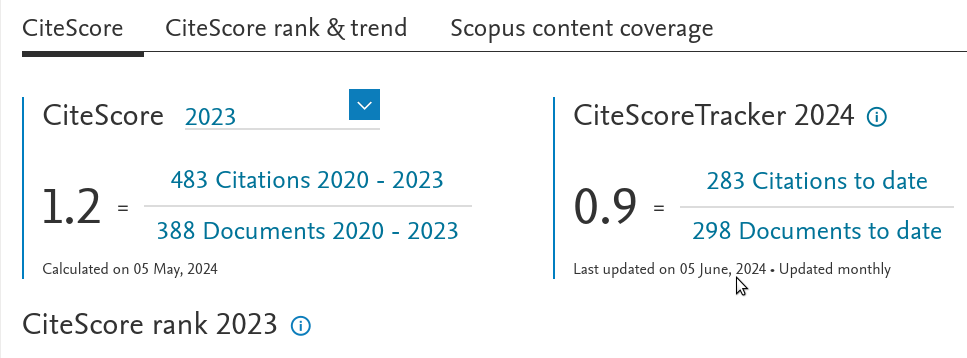Концепція методу Кельвіна на основі механо-електричного перетворення
DOI:
https://doi.org/10.15407/ujpe63.3.269Ключові слова:
nondestructive testing, Kelvin method, contact potential difference, surface charge measurementsАнотація
Застосування методу Кельвiна ґрунтується на концепцiї перезарядки динамiчного конденсатора пiд дiєю прикладеної контактної рiзницi потенцiалiв. В данiй роботi звертається увага на те, що контактна рiзниця потенцiалiв не є таким самим фiзичним чинником, як i рiзниця потенцiалiв, що виникає пiд дiєю електрорушiйної сили. Вона не може дiяти як звичайна електрична напруга i, вiдповiдно, викликати електричний струм перезарядки конденсатора. Реальною причиною появи вимiрюваного сигналу є перетворення механiчної енергiї руху електрода в енергiю електричного струму.
Струм у динамiчному конденсаторi виникає внаслiдок перiодичних змiн умов екранування електростатичних зарядiв, що розташованi над дослiджуваною поверхнею. Проведенi експериментальнi дослiдження вимiрюваного сигналу методом Кельвiна в залежностi вiд кiлькостi заряду на поверхнi зразка показали, що iнтерпретацiя результатiв вимiрювань можлива без застосування поняття роботи виходу з твердого тiла. З цiєї причини метод Кельвiна успiшно використовується у дослiдженнях матерiалiв, до яких поняття роботи виходу не може бути застосовано взагалi: органiчнi та
бiологiчнi матерiали, а також електролiти. Запропонований механiзм виникнення сигналу в методi Кельвiна слiд враховувати при iнтерпретацiї результатiв дослiджень як макроскопiчних розподiлiв поверхневого заряду, так i в атомнiй силовiй мiкроскопiї.
Посилання
<li>J.C. Riviere. Handbook of Surface and Interface Analysis: Methods for Problem-Solving (M. Dekker, 1969).
</li>
<li>Yu.S. Zharkikh, S.V. Lysochenko, S.S. Novikov, O.V. Tretiak. The surface of silicon wafers control after chemical treatments. New technologies 1–2, Nos. 4–5, 18 (2004).
</li>
<li>B. L?agel, I.D. Baikie, U. Petermann. A novel detection system for defects and chemical contamination in semiconductors based upon the scanning Kelvin probe. Surf. Sci. 433, 622 (1999).
<a href="https://doi.org/10.1016/S0039-6028(99)00025-4">https://doi.org/10.1016/S0039-6028(99)00025-4</a>
</li>
<li>G.N. Luo, K.Yamaguchi, T. Terai, M. Yamawaki. Influence of space charge on the performance of the Kelvin probe. Rev. Sci. Instr. 72, 2350 (2001).
<a href="https://doi.org/10.1063/1.1367363">https://doi.org/10.1063/1.1367363</a>
</li>
<li>L. Kronik, Y. Shapira. Surface photovoltage phenomena: theory, experiment, and applications. Surf. Sci. Rep. 37, 1 (1999).
<a href="https://doi.org/10.1016/S0167-5729(99)00002-3">https://doi.org/10.1016/S0167-5729(99)00002-3</a>
</li>
<li>W. Melitz, J. Shen, A.C. Kummel, S. Lee. Kelvin probe force microscopy and its application. Surf. Sci. Rep. 66, 1 (2011).
<a href="https://doi.org/10.1016/j.surfrep.2010.10.001">https://doi.org/10.1016/j.surfrep.2010.10.001</a>
</li>
<li>U. Klein, W. Vollman, P.J. Abatti. Contact potential differences measurement: short history and experimental setup for classroom demonstration. IEEE Transactions on Education 46, 338 (2003).
<a href="https://doi.org/10.1109/TE.2003.813896">https://doi.org/10.1109/TE.2003.813896</a>
</li>
<li>Yu.S. Zharkikh, S.V. Lysochenko. Mechanic-electrical transformations in the Kelvin method. Appl. Surf. Sci. 400, 71 (2017).
<a href="https://doi.org/10.1016/j.apsusc.2016.12.085">https://doi.org/10.1016/j.apsusc.2016.12.085</a>
</li>
<li>W.A. Zisman. A new method of measuring contact potential differences in metals. Rev. Sci. Instr. 3 (7), 367 (1932).
<a href="https://doi.org/10.1063/1.1748947">https://doi.org/10.1063/1.1748947</a>
</li>
<li> J. S.W. de Boer, H.J. Krusemeyer, N.C. Burhoven Jaspers. Analysis and improvement of the Kelvin method for measuring differences in work function. Rev. Sci. Instrum. 44, 1003 (1973).
<a href="https://doi.org/10.1063/1.1686287">https://doi.org/10.1063/1.1686287</a>
</li>
<li> B. Ritty, F. Wachtel, R. Manquenouille, F. Ott, J.B. Donnet. Conditions necessary to get meaningful measurements from the Kelvin method. J. Phys. E: Sci. Instrum. 15 310 (1982).
<a href="https://doi.org/10.1088/0022-3735/15/3/017">https://doi.org/10.1088/0022-3735/15/3/017</a>
</li>
<li> Yu.S. Zharkikh, S.V. Lysochenko, O.V. Tretiak. Application of the dynamic capacitor method in semiconductor sensorics. Sensor Electr. Microsyst. Techn. 10, 36 (2013).
<a href="https://doi.org/10.18524/1815-7459.2013.3.109693">https://doi.org/10.18524/1815-7459.2013.3.109693</a>
</li>
<li> D.K. Schroder. Contactless surface charge semiconductor characterization. Mat. Sci. Eng. B 91–92, 196 (2002).
<a href="https://doi.org/10.1016/S0921-5107(01)00993-X">https://doi.org/10.1016/S0921-5107(01)00993-X</a>
</li>
<li> L.N. Abessonova, Yu.S. Zharkikh, A.D. Evdokimov, V.N. Schetkin. Thickness dependence of physical parameters of thermal oxide films on silicon. Microelectronics J. 20 (5), 461 (1991) (in Russian).
</li>
<li> Yu.S. Zharkikh, S.V. Tychkina. UV-stimulated changes in a charge state of the free surface of the Si–SiO2 system. Phys. Techn. Semicond. 24, 2062 (1990) (in Russian).
</li>
<li> Yu.S. Zharkikh, V.V. Piatnitsky, O.V. Tretiak. Effect of the weak form of adsorption on the Si surface charge. Appl. Surf. Sci. 6, 48 (1998).
<a href="https://doi.org/10.1016/S0169-4332(98)00243-8">https://doi.org/10.1016/S0169-4332(98)00243-8</a>
</li>
<li> K. Jakobi. Electronic and Vibrational Properties (Springer, 1994).
</li>
<li> G.W. Gobely, F.G. Allen. Photoelectric properties and work function of cleaved germanium surfaces. Surf. Sci. 2, 402 (1964).
<a href="https://doi.org/10.1016/0039-6028(64)90081-0">https://doi.org/10.1016/0039-6028(64)90081-0</a>
</li>
<li> F.G. Allen, G.W. Gobely. Comparison of the photoelectric properties of cleaved, heated, and sputtered silicon surfaces. J. Appl. Phys. 35, 597 (1964).
<a href="https://doi.org/10.1063/1.1713422">https://doi.org/10.1063/1.1713422</a>
</li>
<li> L. Nony. Principles of Kelvin probe force microscopy and applications. In: Proceedings of the 1st German-French Summer School on noncontact AFM, Porquerolles, France, (2013), p. 1.
</li>
<li> H. Hoppe, T. Glatzel, M. Niggemann, A. Hinsch, M.Ch. Lux-Steiner, N.S. Sariciftci. Kelvin probe force microscopy study on conjugated polymer/fullerene bulk heterojunction organic solar cells. Nano Lett. 5, 269 (2005).
<a href="https://doi.org/10.1021/nl048176c">https://doi.org/10.1021/nl048176c</a>
</li>
<li> T. Hallam, C.M. Duffy, T. Minakata, M. Ando, H. Sirringhaus. A scanning Kelvin probe study of charge trapping in zone-cast pentacene thin film transistors. Nanotechnology 20, 2 (2008).
</li>
<li> L.M. Liu, G.Y. Li. Electrical characterization of single-walled carbon nanotubes in organic solar cells by Kelvin probe force microscopy. Appl. Phys. Lett. 96, 33 (2010).
<a href="https://doi.org/10.1063/1.3332489">https://doi.org/10.1063/1.3332489</a>
</li>
<li> N.G. Clack, K. Salaita, J.T. Groves. Electrostatic read-out of DNA microarrays with charged microspheres. Nat. Biotechnol. 26, 825 (2008).
<a href="https://doi.org/10.1038/nbt1416">https://doi.org/10.1038/nbt1416</a>
</li>
<li> E. Finot, Y. Leonenko, B. Moores, L. Eng, M. Amrein, Z. Leonenko. Effect of cholesterol on electrostatics in lipidprotein films of a pulmonary surfactant. Langmuir 26, 1929 (2010).
<a href="https://doi.org/10.1021/la904335m">https://doi.org/10.1021/la904335m</a>
</li>
<li> Y. Abbas, X.Zhu, H.L. de Boer, N.B. Tanvir, W. Olthuis, A. van den Berg. Potentiometric measurement with a Kelvin probe: Contactless measurement of chloride ions in aqueous electrolyte. Sens. Actuators, B: Chem. 236, 1126 (2016).
<a href="https://doi.org/10.1016/j.snb.2016.06.150">https://doi.org/10.1016/j.snb.2016.06.150</a>
</li></ol>
Downloads
Опубліковано
Як цитувати
Номер
Розділ
Ліцензія
Ліцензійний Договір
на використання Твору
м. Київ, Україна
Відповідальний автор та співавтори (надалі іменовані як Автор(и)) статті, яку він (вони) подають до Українського фізичного журналу, (надалі іменована як Твір) з одного боку та Інститут теоретичної фізики імені М.М. Боголюбова НАН України в особі директора (надалі – Видавець) з іншого боку уклали даний Договір про таке:
1. Предмет договору.
Автор(и) надає(ють) Видавцю безоплатно невиключні права на використання Твору (наукового, технічного або іншого характеру) на умовах, визначених цим Договором.
2. Способи використання Твору.
2.1. Автор(и) надає(ють) Видавцю право на використання Твору таким чином:
2.1.1. Використовувати Твір шляхом його видання в Українському фізичному журналі (далі – Видання) мовою оригіналу та в перекладі на англійську (погоджений Автором(ами) і Видавцем примірник Твору, прийнятого до друку, є невід’ємною частиною Ліцензійного договору).
2.1.2. Переробляти, адаптувати або іншим чином змінювати Твір за погодженням з Автором(ами).
2.1.3. Перекладати Твір у випадку, коли Твір викладений іншою мовою, ніж мова, якою передбачена публікація у Виданні.
2.2. Якщо Автор(и) виявить(лять) бажання використовувати Твір в інший спосіб, як то публікувати перекладену версію Твору (окрім випадку, зазначеного в п. 2.1.3 цього Договору); розміщувати повністю або частково в мережі Інтернет; публікувати Твір в інших, у тому числі іноземних, виданнях; включати Твір як складову частину інших збірників, антологій, енциклопедій тощо, то Автор(и) мають отримати на це письмовий дозвіл від Видавця.
3. Територія використання.
Автор(и) надає(ють) Видавцю право на використання Твору способами, зазначеними у п.п. 2.1.1–2.1.3 цього Договору, на території України, а також право на розповсюдження Твору як невід’ємної складової частини Видання на території України та інших країн шляхом передплати, продажу та безоплатної передачі третій стороні.
4. Строк, на який надаються права.
4.1. Договір є чинним з дати підписання та діє протягом усього часу функціонування Видання.
5. Застереження.
5.1. Автор(и) заявляє(ють), що:
– він/вона є автором (співавтором) Твору;
– авторські права на даний Твір не передані іншій стороні;
– даний Твір не був раніше опублікований і не буде опублікований у будь-якому іншому виданні до публікації його Видавцем (див. також п. 2.2);
– Автор(и) не порушив(ли) права інтелектуальної власності інших осіб. Якщо у Творі наведені матеріали інших осіб за виключенням випадків цитування в обсязі, виправданому науковим, інформаційним або критичним характером Твору, використання таких матеріалів здійснене Автором(ами) з дотриманням норм міжнародного законодавства і законодавства України.
6. Реквізити і підписи сторін.
Видавець: Інститут теоретичної фізики імені М.М. Боголюбова НАН України.
Адреса: м. Київ, вул. Метрологічна 14-б.
Автор: Електронний підпис від імені та за погодження всіх співавторів.

















